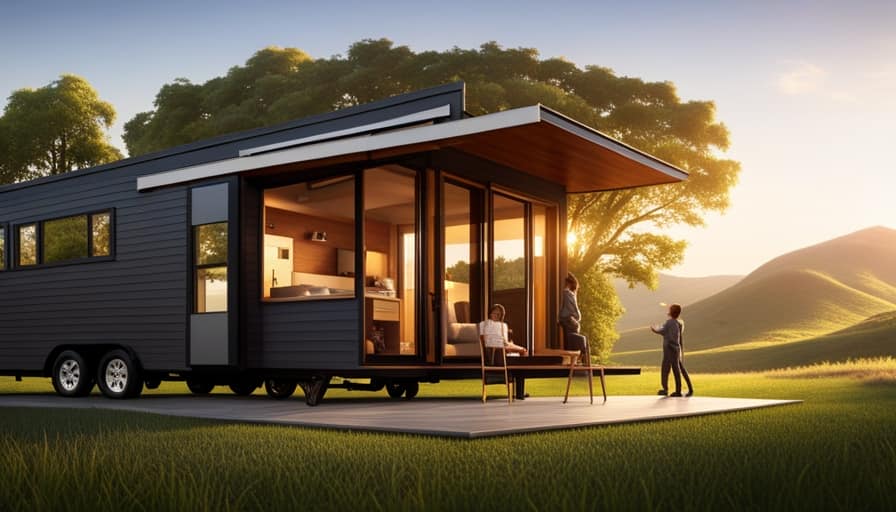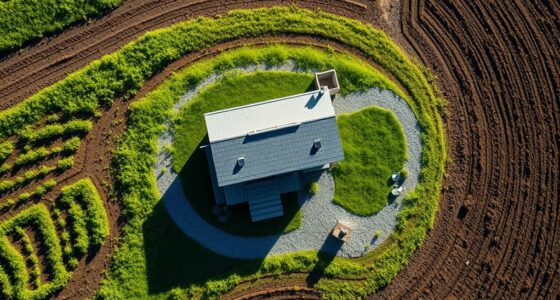Adapting the 50/30/20 budget for tiny-house living means you’ll allocate about 50% of your after-tax income to essentials like low-cost land, utilities, and maintenance, which are considerably cheaper than traditional homes. Use roughly 30% for wants by focusing on sustainable, minimalist lifestyle choices, and dedicate 20% or more to savings and debt reduction thanks to lower mortgage or lease costs. Exploring these adjusted figures helps you maximize your tiny-home budget — discover how to fine-tune your finances further.
Key Takeaways
- Needs typically account for about 30–40% of after-tax income due to lower housing and utility costs.
- Wants decrease, often comprising 10–20%, thanks to minimalistic living and shared community amenities.
- Savings can be increased beyond 20%, as tiny houses reduce mortgage, utility, and maintenance expenses.
- Land costs and permits may temporarily raise needs or fixed expenses but remain manageable within the budget.
- Flexibility in spending allows for personalized adjustments, ensuring the 50/30/20 rule fits tiny-house lifestyle specifics.
Understanding the Basics of the 50/30/20 Rule for Tiny House Living

The 50/30/20 rule provides a straightforward way for tiny-house owners to manage their finances by dividing their after-tax income into three main categories: needs, wants, and savings or debt repayment. Needs include essentials like housing costs—rent, mortgage, utilities such as water, electricity, internet, and heating. Food essentials like groceries, healthcare, insurance premiums, minimum debt payments, and basic clothing also fall here. Wants cover lifestyle expenses that enhance comfort but aren’t necessary, such as dining out, entertainment, hobbies, or travel. The remaining 20% goes toward savings or debt repayment, helping you build financial security and reduce debt faster. This simple framework helps you avoid overspending, promotes intentional living, and aligns well with the minimalist philosophy of tiny-house living. The 50/30/20 rule is flexible enough to accommodate the unique costs associated with tiny homes, such as site fees or land lease costs, ensuring that your budget remains realistic and sustainable.
Adjusted Essentials Expenses for Tiny-House Owners

When managing your finances with the 50/30/20 rule, adjusting your utility and housing costs to fit tiny-house living can make a considerable difference. Solar panels can cut electricity bills to almost zero, especially if grid-connected, or cost about £10/month in the UK. Propane for cooking and heating is around $7/month in the US, with UK costs about £32/month. Rainwater collection and composting toilets can lower water expenses to roughly £10-15/month, reducing municipal water needs. Composting toilets eliminate sewer costs, and propane or electric space heaters cost only about $50–$100 annually. Mortgage or land lease payments are substantially lower, often around £480/month, with potential savings on council taxes and maintenance. These adjustments keep essential expenses lean in tiny-house living. Efficient water management can further reduce recurring costs and promote sustainability.
Reimagining Wants in a Tiny House Lifestyle
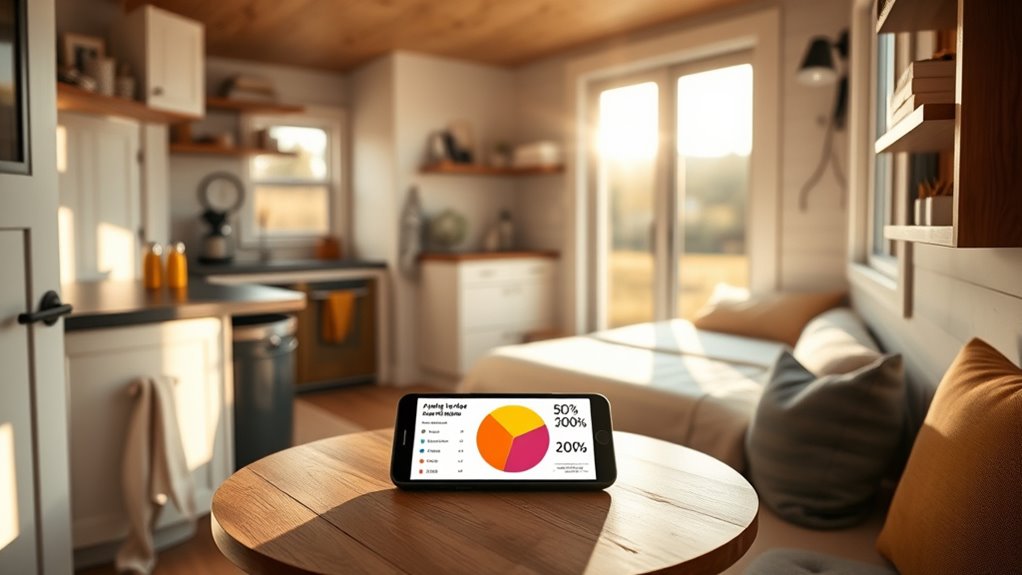
Living in a tiny house encourages you to rethink your wants by embracing minimalism and simplifying your lifestyle. You learn to prioritize essential items and let go of clutter, focusing on purposeful possessions. Instead of accumulating extras, you choose multi-functional, space-saving products that suit your small space. This shift reduces maintenance needs and minimizes home care costs. Environmentally conscious owners seek eco-friendly, sustainable options, aligning wants with conservation. Community living also redefines wants—shared amenities like gardens, workshops, and recreation areas replace private yards, lowering individual expenses. You begin to value collective resources, such as shared utilities and adaptive infrastructure like solar panels or communal energy systems. Additionally, understanding the importance of efficient design in tiny homes helps maximize functionality within limited space. This reimagining of wants emphasizes efficiency, sustainability, and social connection, transforming your approach to possessions and lifestyle in a tiny home.
Strategic Savings and Debt Management for Tiny Home Owners
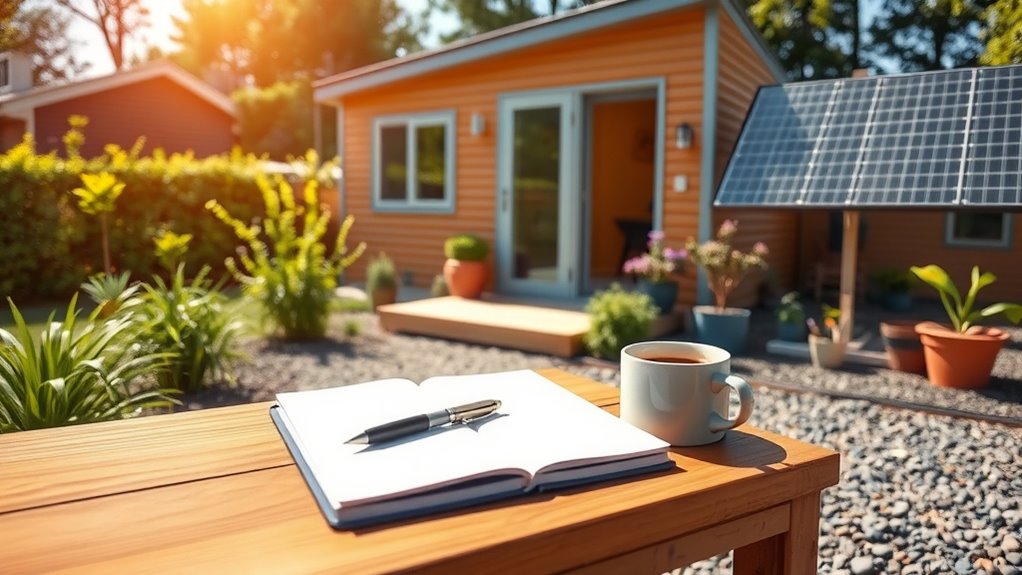
To stay financially secure in your tiny home, you need a solid strategy for saving and managing debt. Building an emergency fund and planning for future repairs help you handle unexpected costs, while smart debt management keeps your finances flexible. By focusing on these areas, you can enjoy your tiny home without financial stress. Costs can vary, so understanding regional price differences and planning accordingly can further enhance your financial stability. Incorporating budget-friendly decor ideas can also help you maintain a cozy, appealing space without overspending.
Prioritizing Emergency Funds
Prioritizing your emergency fund is essential for tiny-house owners because unexpected costs can arise quickly due to the unique aspects of small living. You should aim for 3–6 months of essential expenses, including utilities, repairs, and potential relocation costs. Use conservative estimates to cover off-grid system fixes or moving fees, and regularly reassess your goals as costs fluctuate. To build this fund gradually, start small—$25 or 5% of your income—and automate transfers into a high-yield account. Cutting discretionary expenses, selling unused assets, or leveraging windfalls can boost your savings faster. Focus on steady growth rather than lump sums. Incorporating financial planning tools can help you track progress and adjust your strategy accordingly. Here’s a quick overview:
| Saving Strategies | Key Actions |
|---|---|
| Building Emergency Savings | Automate transfers, celebrate milestones |
| Reducing Spending | Cut non-essentials, negotiate bills |
| Liquidating Assets | Sell items, organize sales |
| Windfalls & Side Income | Allocate bonuses, freelance work |
Managing Construction Debt
Managing construction debt effectively is essential for tiny-house owners to avoid financial strain and guarantee smooth progress. Start by understanding your loan options—personal loans, RV or chattel loans, home equity loans, or builder financing—each has different rates and terms. Keep your credit score above 620 and maintain a low debt-to-income ratio under 43% to qualify for better interest rates, reducing overall costs. Make a sizable down payment—ideally at least 20%—and include all upfront costs in your budget to prevent surprises. Develop a repayment plan aligned with your income, prioritizing high-interest loans first. Automate payments to stay current, and consider refinancing later to improve cash flow. Careful cost estimation and strategic savings help keep construction debt manageable and avoid unnecessary borrowing.
Budgeting for the Costs of Building and Maintaining a Tiny House

Budgeting for building and maintaining a tiny house involves careful planning to cover both upfront costs and ongoing expenses. First, consider land costs, which can range from $5,000 to $25,000 per acre depending on location and zoning. Construction expenses vary widely, from $30,000 to $150,000, with prefab options costing between $15,000 and $120,000. Larger homes (600-800 sq ft) tend to be more expensive, often exceeding $110,000. Permit and utility fees add extra costs that differ by area. For maintenance, plan for annual repairs, energy-efficient upgrades, renewable energy systems, and appliance replacements. Construction costs can be affected by the choice of materials and labor, impacting your overall budget. Long-term costs like utilities, insurance, taxes, and land management are generally lower but still require budgeting to ensure your tiny house remains functional and comfortable over time. Additionally, understanding zoning regulations is essential to avoid legal issues and ensure your tiny house complies with local laws.
Benefits and Opportunities of a Tiny House Budgeting Approach
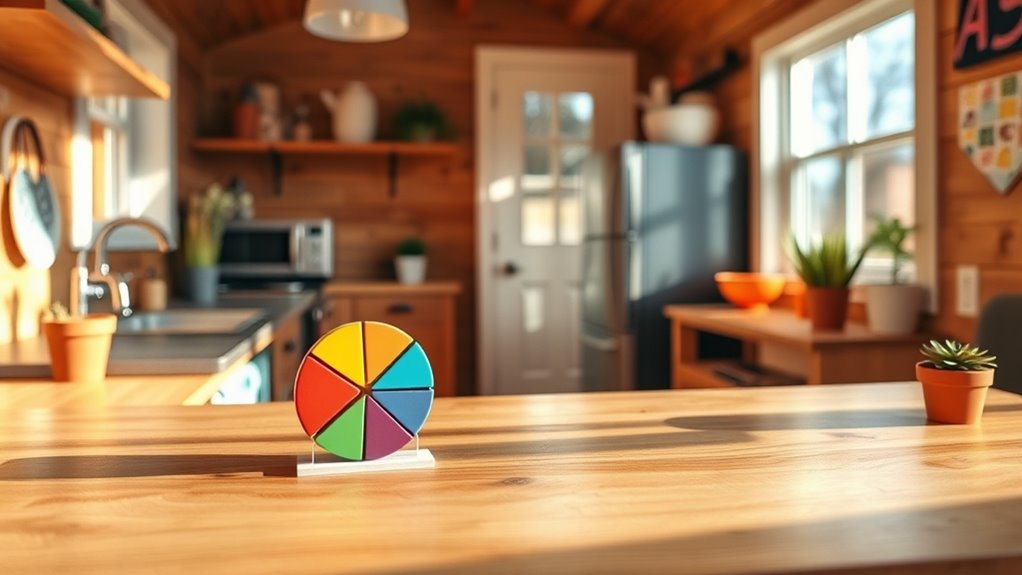
Adopting a strategic approach to budgeting for a tiny house can access significant financial benefits and open up new opportunities. With lower purchase prices, mortgage payments, and utility bills, you save hundreds each month. Tiny homes often cost between $23,000 and $75,000, compared to traditional homes exceeding $272,000. Utility costs drop to about $50–$100 monthly, and insurance is substantially cheaper. This savings potential frees up funds for investments, debt reduction, or early retirement. Environmentally, tiny houses consume up to 90% less energy and use sustainable materials, boosting eco-friendly living and eligibility for incentives. Additionally, the compact size simplifies maintenance, reduces clutter, and enhances mobility—allowing you to adapt quickly to changing circumstances while enjoying financial stability and a more intentional lifestyle. Staying aware of AI-related vulnerabilities and the importance of AI safety measures can help ensure your smart home systems remain secure and reliable.
Frequently Asked Questions
How Do Tiny House Insurance Costs Compare to Traditional Home Insurance?
When comparing tiny house insurance costs to traditional home insurance, you’ll find tiny home policies are generally more affordable, averaging around $852 annually. They cost just 1-2% of the home’s value, with premiums increasing modestly as the size grows. You also gain flexibility through hybrid policies that cover mobility, transit risks, and sometimes rental use, making tiny house insurance a cost-effective, tailored option compared to traditional home insurance’s higher and more fixed rates.
What Are Typical Maintenance Expenses for a Tiny House Annually?
You might think tiny house maintenance is minimal, but it actually requires steady upkeep. Regularly, you’ll spend around $500 to $1,000 annually on routine tasks like roof checks, appliance servicing, and painting. Setting aside $1,000 to $2,000 for unexpected repairs is wise. Overall, expect about $800 per year for basic maintenance, which is less than traditional homes, thanks to the smaller size and fewer systems needing attention.
How Can Tiny House Owners Maximize Savings With Limited Space?
To maximize savings in your tiny house, focus on smart space management. Use multi-functional furniture to reduce clutter, choose energy-efficient appliances, and optimize window placement for natural light. Incorporate passive solar design and thermal insulation to lower heating and cooling costs. Additionally, install water-saving fixtures and consider rainwater harvesting. These strategies help you cut expenses, reduce resource use, and enjoy a more sustainable, cost-effective tiny home lifestyle.
Are There Specific Tax Benefits or Credits for Tiny House Dwellers?
You might think tiny house living offers no special tax benefits, but that’s not true. You can deduct mortgage interest and property taxes if you itemize, just like traditional homeowners. If your tiny house is on wheels, it may have different tax implications, but renting it out or using it for business can also open up deductions. Always check with a tax professional to maximize your benefits.
How Should Tiny House Owners Budget for Land Lease or Purchase Costs?
When budgeting for land lease or purchase costs, you need to consider location, utility availability, and lease terms. Rural land is cheaper but may lack hookups, while urban land costs more but includes utilities. Decide between leasing or buying based on your finances, and factor in additional expenses like permits, land preparation, and ongoing maintenance. Planning ahead ensures you cover all costs and avoid surprises in your tiny house journey.
Conclusion
By following the 50/30/20 rule tailored for tiny house living, you can confidently manage your finances and maximize your savings. Did you know that tiny homeowners save up to 45% on monthly expenses compared to traditional homes? This budgeting approach not only helps you stay on track but also opens doors to more adventures and financial freedom. Embrace the flexibility and make your tiny house lifestyle both affordable and fulfilling.
I’m Theodore, and I love tiny houses. In fact, I’m the author of Tiny House 43, a book about tiny houses that are also tree houses. I think they’re magical places where imaginations can run wild and adventures are just waiting to happen.
While tree houses are often associated with childhood, they can be the perfect adult retreat. They offer a cozy space to relax and unwind, surrounded by nature. And since they’re typically built on stilts or raised platforms, they offer stunning views that traditional homes simply can’t match.
If you’re looking for a unique and romantic getaway, a tree house tiny house might just be the perfect option.









